Feeling stymied? In a slump? Disconnected from your work? You’re not alone.
We’re all familiar with writer’s block from the many cinematic clichés. The author sits at his typewriter or word processor, smoking and drinking and muttering profanities. The author fills a sheet of paper with a few tentative scrawls, wads it into a ball and tosses it into a corner, to join the many other balls of wadded-up paper. The author tosses her laptop into the Hudson, the Seine, the blue Pacific (well, I haven’t actually seen this one, but it can’t be long in coming).
But artist’s block? I can’t recall a single movie that features the painter/sculptor/video artist staring hopelessly into space or suffering a panic attack in the studio or moaning in despair at the works on the walls. And yet from the ten or so site members interviewed, it seems that artist’s block is not an uncommon thing.
The symptoms can range from total paralysis to outright panic to feelings of doubt and inauthenticity. “I didn’t talk to anyone. I literally quit making art because I felt I had nothing to say, and I began questioning my whole identity,” says Jim Condron, whose show at the Julio Fine Arts Gallery at Loyola University in Baltimore, MD, just ended. “I was looking at all kinds of other things, asking, What do I want to do? Open up a hot-dog stand? I’m not qualified to do anything else.” Similarly Karen Jilly, who recently relocated to Los Angeles, says, “I lost my drawing confidence. Some mornings I would wake up and think, ‘I don’t know how to draw.’ I would do a Google search on ‘how to draw.”
At its worst, there may be tears: “The most extreme for me was when I was crying on the floor,” says Tamar Zinn. “I had made my first forays into abstraction in the early ‘90s. I knew I was on to something exciting, but it was terrifying at the same time, and I was filled with self-pity. I would come into the studio, thinking, ‘Okay, today I’ll be able to get back into it,’ and that wouldn’t happen.”
Among those interviewed, the average block seems to be about three to nine months, with two years at the outer limits. Alison Berry says that when she made a radical switch in her approach to her painting in 2004, that was how long she needed before she started feeling good again. “It’s not that I didn’t work at all,” she admits. “I made attempts, but I was experiencing a shift in perspective at the time, and a lot of my work has been about undoing things I was taught in the Western tradition of painting. So change was hard.”
Causes of artist’s block seem to fall into almost predictable patterns. The loss of or disruption to a working environment can provoke a period of feeling stymied. While she was building a new studio at her Wetport, CT, home, says Niki Ketchman, she found herself without a place to do much of anything. When the studio was finally ready (the four months expected for completion turned into a year), her mind suddenly went blank. After recently moving from Phoenix, AZ, to Los Angeles, Jilly also went through a period when she felt off track and out of balance. “I can’t relate to what I started in Arizona,” she says. “I have three big wooden panels with drawings and paintings, and now they’re not working for me.”
Jilly adds that part of the problem was the pressure of being in a new place, telling herself, “I need to meet new people, I need to find a gallery.” She knew, intellectually, that “it’s not about the art itself,” but that doesn’t necessarily make the block any easier to overcome.
Not surprisingly, the death of a loved one can mean a serious disconnect from the art. “We had an Australian shepherd dog who was very dear to us, and we had to put her to sleep,” says Brenda Goodman. “I couldn’t paint for nine months after that. I couldn’t go into the studio. Then one day I painted myself looking around, bewildered. I showed myself in a quandary about getting back into the studio and about what I was going to paint. I included things that were dear to me and pleased me visually.” Pookie, the beloved dog, is in the painting to the far right of Goodman’s six- by- six-foot canvas Quandary.
What To Do?
As Goodman suggests, there’s a Catch-22 here: the work itself can become a kind of cure if only you can get back to work. “When my mother died, when my father died, I’d work out my grief in a painting, The way I got through hard times was to paint it right away, but when we lost Pookie, I couldn’t get myself to paint her. ” she says.
Tamar Zinn says she finds her way out of a funk by looking at other artists. “I turn to the ones who give me great comfort,” she says. “If I look at Morandi or Diebenkorn or Giotto, I fall in love again, and that takes me away from my misery and gives me a sense of renewal. It doesn’t solve the problem, but it does tell me to keep going.”
Switching mediums for a time can also help. When she went through a radical transition from Detroit to New York in the late 1970s, Goodman “did sculpture for a while before I could get back into painting. Sometimes you have to open yourself up and do something unfamiliar. The works were about how I was feeling at the time, isolated and alone.”
“I just finished a long block, and it lasted three months,” says Nicola Newton, who lives and works in Santa Rosa, CA. Then I remembered that I had filled an entire sketchbook during that time—so was it a block or was it something else? I used Magic Marker, a medium I’m very uncomfortable with. Once you put the mark down, you have to live with it.”
“I tried doing different things,” says Niki Ketchman. “Doodling, sitting around thinking. I started making 12- by 12-inch collages, using images I saw in magazines and putting resin on the surface. One thing led to another and I’m back into sculpture, with two new series going on.”
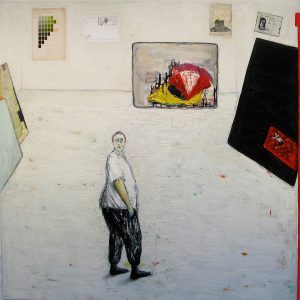
The death of a beloved dog, here shown in the painting at far right, is commemorated in Brenda Goodman’s Quandary (2011)
Oftentimes the most mundane activities can snap an artist out of the doldrums. “I might build a stone wall or plant a garden or paint my back room or clean up the kitchen, directing my creative energies in some other way,” says Berry. “I had to learn to allow myself to take a break,” adds Zinn. “Going for a walk or taking a nap.”
Alexander Warnow, a family and marriage therapist whose practice is in Alameda, CA, and who has also worked as a “creative coach,” agrees that often simple breaks can provide a cure. “Maybe it’s taking a vacation or going to a movie or laughing for a few hours,” he says. “Or just get off the internet for a day.
If the block goes on too long for what he calls a “natural unfolding of your creative consciousness,” it may not be a bad idea to seek out professional help. There may be other unconscious barriers at work—fear of failure? fear of success?–or maybe just an excess of stress. Do a Google search for “creative coaching” and call around to find someone you feel comfortable with.
A big part of understanding blocks, Warnow adds, is to know that “it’s part of the process and doesn’t mean there’s anything wrong with you.”
Artists who have been working for years come to realize, as Zinn puts it, that “creative work needs a different kind of nourishment” and occasional slumps are to be expected.
After the upheaval from Phoenix to Los Angeles, Karen Jilly says she is “trying to get into a routine, to be healthier. I’m back to getting up early, listening to a music track when I work out in the morning. I make little notes to myself. I saw photos I had bookmarked in National Geographic for inspiration, and now my mind is starting to slip back into art.
“I’ve gone through this so many times that I know I’m close to coming out of it,” she adds. “I have to get to a point here my desire is bigger than my lack of confidence, and because I’ve been through this before, I know how to get myself out of it.”
Over the years, says Newton, she has learned that “every block seems to be time not wasted, and that good new work emerges in the end. Every time!”
Ann Landi
Top: Alison Berry with a work in progress, Habitable Zone, acrylic, ink, pigment and colored pencil on Evolon microfiber, 48 by 90 inches.
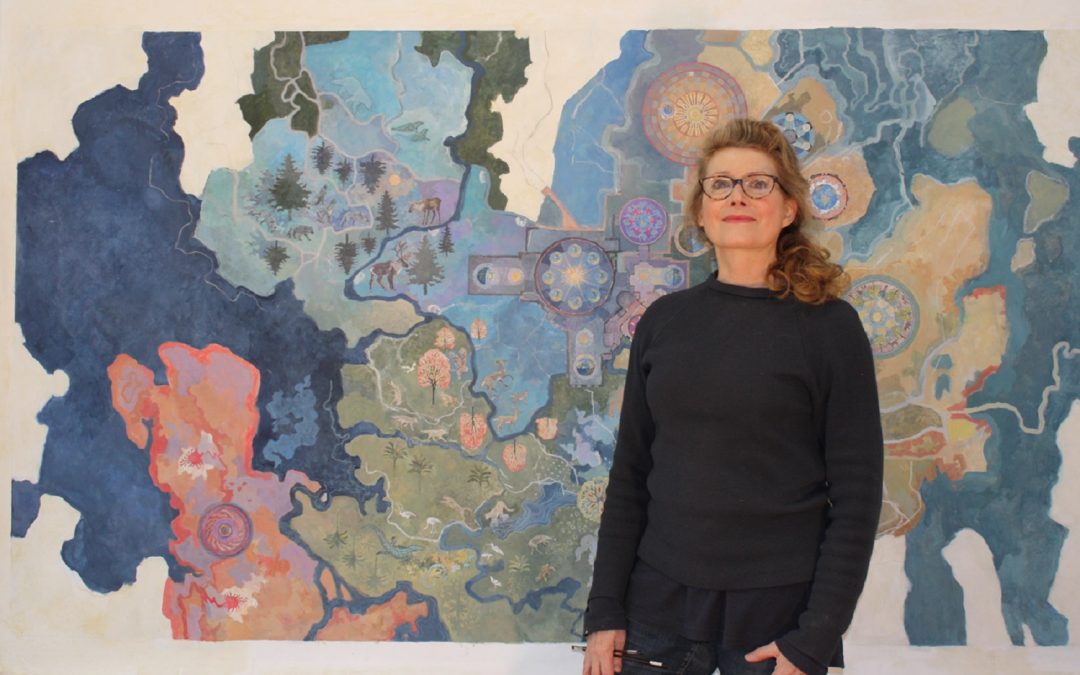
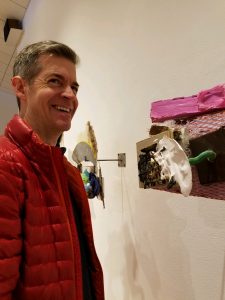
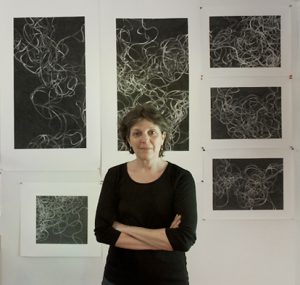
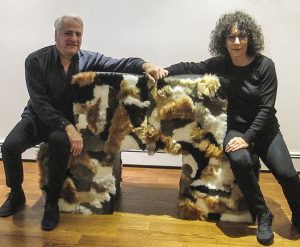
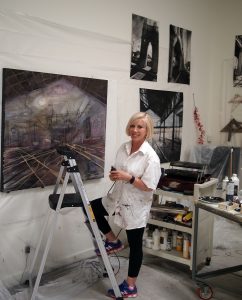
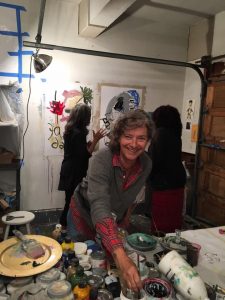
This is a terrific article. It will soothe artists who are experiencing a block for the first time. They will see that they are not alone and that there is an end to the tunnel.
I find that I take walks everyday and write in my journal. I have not felt blocked for a long time. I always have something to do related to my art since I have an idea that seems inexhaustible, the Counter Monument, sculpture. But writing and walking, letting the tortoise brain (right brain) nurture itself is so important. I have no internet at home or music right now. I work at the university where I work. So this down time is really important. It is so hard today to disconnect from the web and that is destructive because it pulls you out of your core-center.
Without tempting fate, I have found that the older I get the less this is an issue, if at all any more. I used to empty myself into the work in a whirl of passion and emotion which, looking back, inevitably left me empty and exhausted…and then I’d panic and get depressed for up to 3 months on occasion, convinced I’d never paint again with a feeling that my life was over…Until it would suddenly all come tumbling back out of me again. I now find I simply let each work inform the next, always taking aspects of the old into the new.. In short, I don’t beat myself up anymore (perhaps I should!) trying to get quite so above and beyond myself. I think my creativity is allowed to flow more like a stream than the neurotic, hurricane force it used to be. I carry a confidence (again perhaps erroneously) that things will keep evolving in the quiet hope that I’ll create that elusive mother of all works, one day! Or maybe, with age, I just don’t have the energy to worry about it anymore?!
These comments and the words from Brenda ( whose work I love ) has come at a time that has almost convinced me that “I’m done..I’m empty and have nothing more to say” ..because of guillan barree and parallysis and rheumatoid arthritis….but having not had the confidence for at least a year I’m planning to go back in my studio and see what I am able to achieve.
As for age,well, I’m 86 but so many artists are still,creating amazing work ie Charles McGee at age 92 and in a wheel chair after a stroke 5years ago.
This article is so helpful especially since artists work in isolation…so thank you
In the past year or so I have steadily been coming out of a 10 year block. Prior to that, I did not believe in “blocks”; I considered those “down/disconnected” times to simply be part of the process. But a perfect storm of dislocation/life difficulties/ emotional upheavals created a condition that I had to fight long and hard to get beyond and I came frighteningly close to abandoning my studio life all together. I did continue to make work and even show during this time, I kept my commitment to daily practice both as a photographer and a painter (though it faltered occasionally) and I could recognize that I was producing work that people responded to favorably. But I had completely lost connection to the thread of growth that is critical to my enjoyment of process. I felt as if I was simply rehashing themes and resting on tried & true devices and it was devastating; when I threw caution to the wind, I couldn’t stand the results. The emergence from this place was slow, subtle yet steady and while it still feels tentative, I once again have a studio practice that is committed and challenging and I once again can say unreservedly that I am fully engaged in finding and expressing “truth”
“I lost my drawing confidence. Some mornings I would wake up and think, ‘I don’t know how to draw.’ I would do a Google search on ‘how to draw.” This is me. I lose my nerve and research how to draw, paint, technical information about mediums I’ve mastered. Years ago, changing mediums led to my mature work.